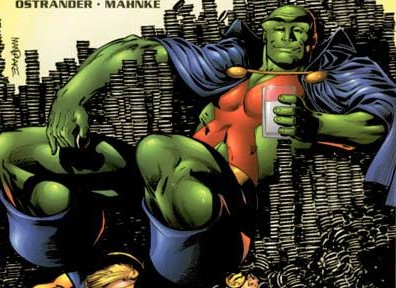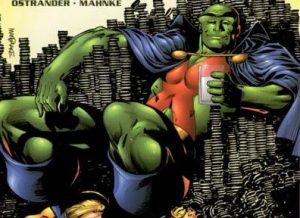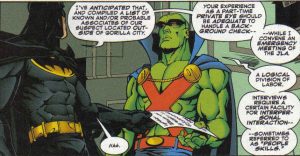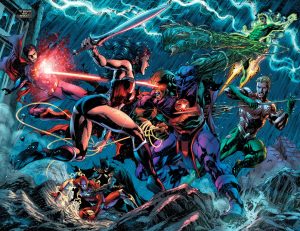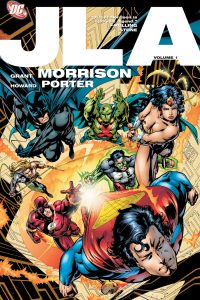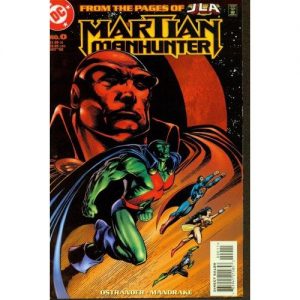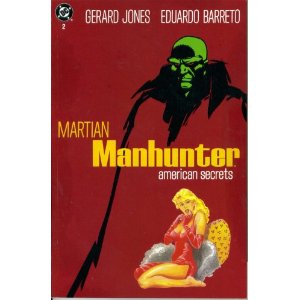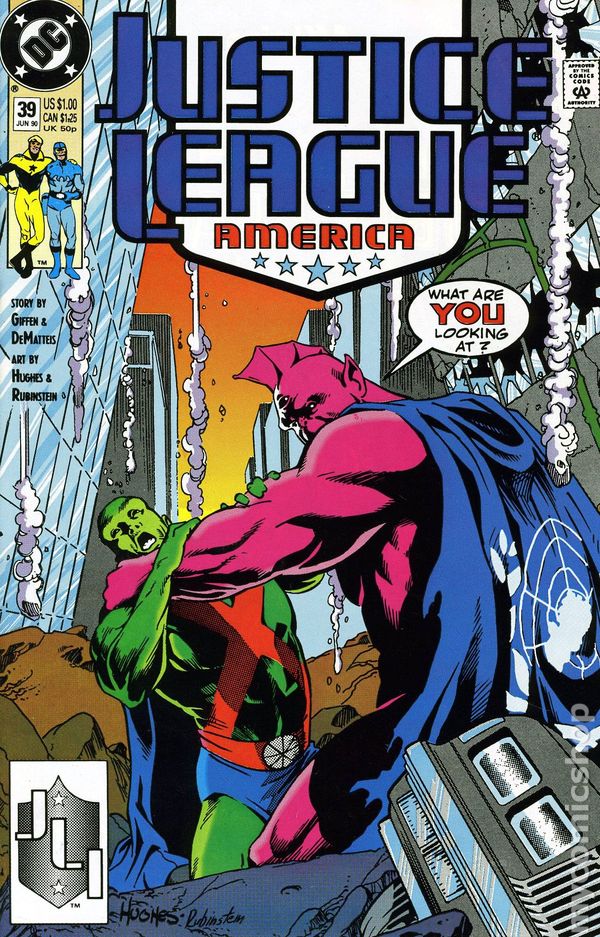Spanning the Universes: J’onn J’onzz
“Spanning the Universes” spotlights a different comic book character every week and suggests stories featuring those characters for you to seek out and gleefully devour. Want to see your favorite character featured in this column? Make suggestions in the comments and let us know who you’re passionate about!
WHO are they?
Since the Martian Manhunter debuted in Detective Comics #225, his origin has been fiddled with enough to start its own Bluegrass festival. But while the details have changed and changed again, the basics have remained largely the same throughout:
Transported unwillingly from Mars (like John Carter in reverse), J’onn J’onzz, the Martian Manhunter, finds himself stranded on Earth. He assumes a human identity – John Jones, Police Officer/Private Detective – and helps to found the Justice League. With a wide array of abilities (shape-shifting, intangibility, flight, strength and telepathy being the most commonly used) and a thoughtful, zen-like demeanor, J’onn becomes the soul of the League in many of the team’s incarnations over the years. Finding solace, companionship, and a surrogate family among the heroes of his new world, J’onn puts his race’s phenomenal powers to work for the sake of truth, justice, and the Ma’aleca’andran way.
Through the years, DC’s treatment of Mars and J’onn’s fellow Martians slowly changed. Originally, J’onn was portrayed as living on Earth apart from a still-thriving Martian culture. After DC’s Crisis on Infinite Earths, where large parts of DC’s continuity were rewritten or discarded, J’onn’s history was revised. Now J’onn’s fellow green Martians – including his wife and daughter – were long-dead, leaving him alone to forge a new family on Earth. This is the version of the Manhunter that’s arguably best known, prior to DC’s New 52 initiative, which “reset” the DC universe.
The New 52:
J’onn’s history is a mystery in the New 52. He’s worked with a secretive group called Stormwatch toward a mysterious agenda. He’s assisted the Green Lantern Corps while carrying out the same mysterious agenda. He briefly joined the main Justice League title, only to have a knockdown, drag-out fight with Supes & Co. – over a mysterious agenda one assumes (noticing a pattern here?).
Is Mars still a dead world? Are J’onn’s wife and child dead? Was he brought to Earth by mistake? Is his New 52 origin relatively similar to what’s come before? Is he still vulnerable to fire?
….Does he still love Oreos?
We’re told that J’onn “wants humans to think he’s the last Martian; a noble, tragic orphan. But…”
… But what? Is that version of J’onn’s history being revised in the New 52? Will DC return to the idea of Mars as an inhabited world? Perhaps a hostile one? We’ll have to wait and see.
WHY should I care?
Because J’onn is a deadpan Philosopher/Detective with the soul of a warrior-poet. Because the best stories featuring his character tend to be rooted in the sort of pulpy, fantastical stuff that comics can still do better than film or television. Because whether he’s in the role of put-upon adult in a room full of overgrown children, devoted and selflessly-valiant founding member of the JLA, or otherworldly, cosmic philosopher/warrior, J’onn is a rock of calm authority, moral clarity and dust-dry deprecating wit. It makes him fun to read.
At first glance, J’onn Jonzz’s backstory seems like a retread of Superman’s: last survivor of a dying world is transported to Earth, where he takes up the hero’s mantle. But reducing the Manhunter to a Superman knock-off does the character a disservice.
Clark Kent came to Earth in the guise of an adorable human infant, and was raised by salt of the earth parents with bedrock-solid values. His is the plight of the orphan baby – a man who grieves for a world he never truly knew. For Clark Kent, the trauma of an exploding Krypton is a story he is told. For J’onn J’onzz, the death of Mars is a holocaust witnessed firsthand.
But unlike, say, Batman, whose childhood traumas have damaged him permanently, J’onn refuses to let pain define who he is. Though reserved and stoic, the Manhunter is also curiously familial, given to sentiment, to cutting sarcasm, and to the simple pleasures of oreo-like cookies. This contrast can be a lot of fun to read – especially when J’onn is stirred into the mix with other, more outwardly colorful characters.
There’s a slightly-daffy Silver Age sensibility to the Martian Manhunter – a retro-futurism that’s cool in the way that Flash Gordon and John Carter and Ray Bradbury’s descriptions of rockets are cool. A bright-green, musclebound, beetle-browed martian looks right at home fighting, say, a despotic mind-controlling cosmic starfish or reshaping his brain in order to think like the Joker would. Several stories featuring J’onn have delved into this aspect of the character to great effect.
There are literally no limits to the sorts of stories that talented writers can tell with the character, and his alien origins give those same writers a big, inviting canvas to paint on. Not enough of those writers have taken the opportunity to do so. J’onn has too often been set up as the League’s “communications expert,” which basically means that he links everybody up telepathically and is then taken down by whatever enemy is being fought that week to show the audience just how dire the threat is (“If they could take down J’onn then they can take us all!”).
We don’t really know what we’re going to get with J’onn’s New 52 incarnation just yet. DC has systematically set out to destroy all evidence that the Giffen/DeMatteis era ever existed, so we’re not likely to see any Oreos or straight-faced sarcasm in the near future. This J’onn seems darker, and he’s far more ambiguous in his actions. So far it’s a refreshing take on the character, and a good example of how the New 52 concept can make familiar characters newly intriguing by playing against existing expectations. By introducing the Manhunter as an infiltrator of powerful organizations, DC is positioning J’onn to be something other than a “green Superman.” Showing him in conflict with the rest of the League sets up a drastic redefinition of who this character is. To anyone familiar with J’onn, the image of the Manhunter thoroughly trashing the League is as shocking as Alfred betraying Batman.
Writers like Paul Cornell, Peter Milligan and Geoff Johns have taken a character that fans knew and loved in the manner of old, comfortable shoes, and given him an aura of ominous mystery that he’s never had before.
WHAT should I read?
Stormwatch issues #1-12 (The New 52)
Several characters and concepts from Jim Lee’s Wildstorm imprint were folded into DC’s relatively-recent New 52 initiative, including Stormwatch. A clandestine group directed by a mysterious “Shadow Cabinet,” Stormwatch exists to protect the New 52 universe from cosmic-level threats, the likes of which most DC heroes aren’t even aware of. These issues feature the majority of J’onn’s appearances in the New 52 so far, introduce a great villain, get pleasingly cosmic and wacky, and paint an intriguingly-ambiguous portrait of J’onn J’onzz. Stormwatch suffers to some extent from a lack of great characterization and a focus on spectacle over team interplay, but the concepts are nifty and it’s where you’ll find the Manhunter in the New 52 prior to his reemergence as part of Justice League America this February. Here’s hoping Johns nails it.
Stormwatch #1-6 has been collected as Stormwatch vol. 1, which you can buy wherever DC books are sold. Stormwatch #7-12 has been collected as Stormwatch vol. 2, and will be released on February 19th.
JLA, Issues #1-4
After a decade or more in which the Justice League was populated by “second-stringers” like Mister Miracle, Blue Beetle and Booster Gold, Morrison and Porter relaunched the team as a widescreen, cinematic endeavor starring DC’s “Big Seven”: Superman, Batman, Wonder Woman, Green Lantern, Flash, Aquaman and…Martian Manhunter. Gone was the jokey bickering and the absurdist humor. In their place Morrison introduced widescreen blockbuster action sequences and kooky/smart Big Ideas.
JLA’s first arc is fairly J’onn-centric, and a cracking good story to boot (Batman fans will love it). Morrison pays homage to the League’s initial formation and sets the tone for the series to follow: Ocean’s Eleven with superheroes. Each of these heroes is a professional, there to do their job. Each is an expert in his or her respective “field.” There’s none of the all-too-typical “lets fight before we team up,” and no feints made toward internal tension within the team. Instead, Morrison takes time to showcase what makes each of the members nifty. Howard Porter’s art complements Morrison’s intended feel perfectly, and his rendition of J’onn remains among the best. A great start to a great run.
JLA Issues #1-4 was originally collected as “JLA: New World Order,” and that collection can likely be found online and at various stores. Those issues have since been recollected as part of “JLA Vol. 1,” and can be bought pretty much anywhere.
Martian Manhunter, Issue #0 & Issues #4-9
In the Manhunter’s only self-titled solo series to date, writer John Ostrander and artist Tom Mandrake embrace the character’s schizophrenic history and largely succeed in melding decades of the stuff into a cohesive whole. Ostrander amps up the cosmic threats, the psychodrama, and the exploration of J’onn’s history and culture. He weaves the Manhunter’s history into that of Darkseid and Apokolips, and most importantly, he gives the character a supporting cast and a rogue’s gallery that, if not wholly inspired, is pretty unique. Ostrander’s Spectre collaborator, Tom Mandrake, joins him on this title, and Mandrake’s horror-laden background help to give this book an otherworldly vibe. This is a terrific, underrated series and it’s a crime that DC hasn’t seen fit to collect the run in graphic novel form.
Issues #0 and #4-9 tell a complete origin story for both J’onn and the title’s best villain – J’onn’s twisted brother (who some of you may recognize from DC’s recent animated effort, “Justice League: Doom”). Over the course of the story Ostrander redefines who J’onn J’onnz is in a newly BWAHAHA-free DC universe. These issues, and the entirety of the Ostrander/Mandrake run, can be purchased cheaply online and at your local comic book store.
Martian Manhunter: American Secrets
This one’s just plain neat. Set in the 1950s and drawing on what seems like every major American trend of the era (UFOs, Roswell, Beatniks, Communism, hard-boiled detective fiction, suburbia, Elvis Presley, the rise of TV quiz shows, and…uhh…lizard monsters), American Secrets spins an unabashedly goofy/dark and kinetic tale, playing to the character’s pulpy roots and whipping up a retro-hallucinatory good time. If the idea of J’onn J’onnz and an Elvis Presley analogue getting pulled into a conspiracy of lizard men doesn’t make you grin I suspect you may be dead inside. It’s not for everyone, but for some of you it’ll be a hoot.
Martian Manhunter: American Secrets was published as an out-of-continuity miniseries, and is available in three slim individual volumes. It has not been reprinted or collected into a single trade. Copies are available for purchase at reasonable prices from comic shops and various online sellers. It’s worth tracking down.
Justice League International
The Manhunter has never been better than he was in Giffen and DeMatteis’ rollicking stories, acting as team leader/continually-exasperated den mother for a squabbling group of second-stringer heroes who’d rather play practical jokes on each other than save the world. DeMatteis and Giffen give J’onn Jon’zz a bone-dry sense of humor, a fondness for Oreo cookies, and a stoic warmth (three attributes that are so far missing and much-missed in his New 52 incarnation). The art, by Kevin Maguire and Adam Hughes, emphasizes character over all – the facial expressions alone are worth the price of admission. Still amusing and entertaining over twenty years after publication, JLA/JLI is worth a look for those seeking to relive DC’s much-missed “BWAHAHA era.”
The Giffen DeMatteis run has been collected as a series of “Justice League International” graphic novels and it’s well worth your time. I’m singling out JLA 38-40 because it breaks the typical mold and tells a deadly-serious story featuring J’onn that’s terrific. Longtime Justice League adversary Despero returns to Earth to take revenge on a version of the League that no longer exists, and it’s up to J’onn to stop him. Adam Hughes’ art is wonderful, and the story is tense, exciting stuff.
Justice League International Vols. 1-6 are available and recommended. Unfortunately, this story line hasn’t been collected, though if DC prints a JLI vol. 7 it will be. Until then you can find the individual issues for a reasonable price at conventions and online.
